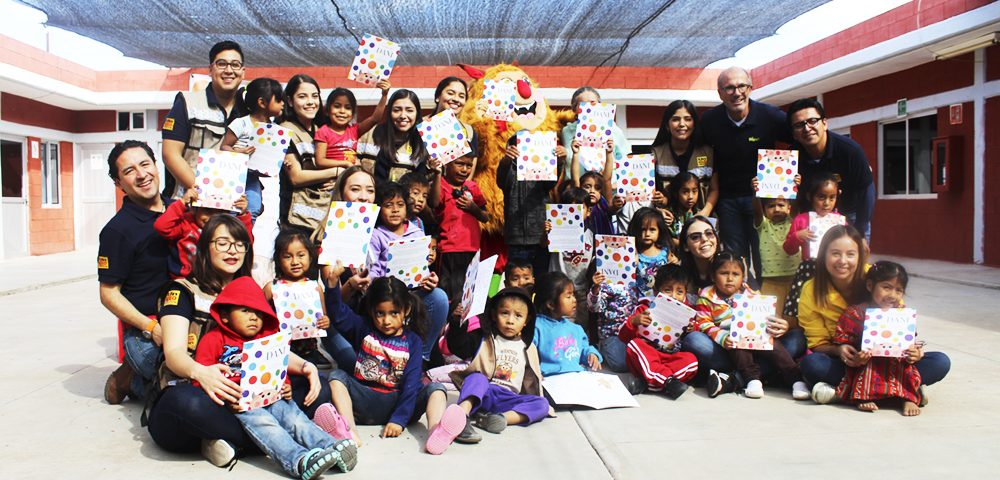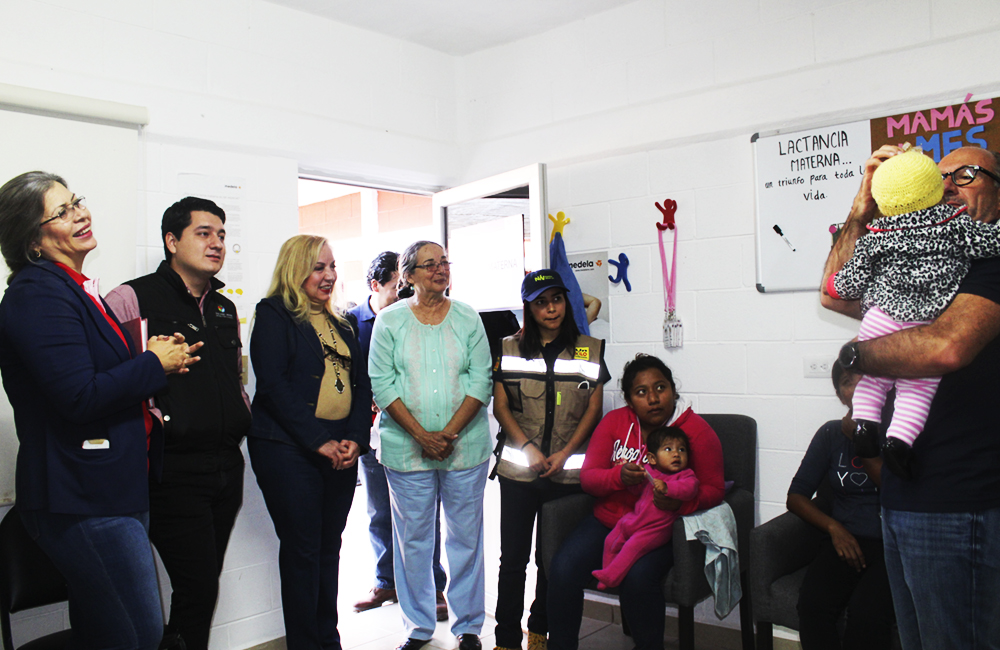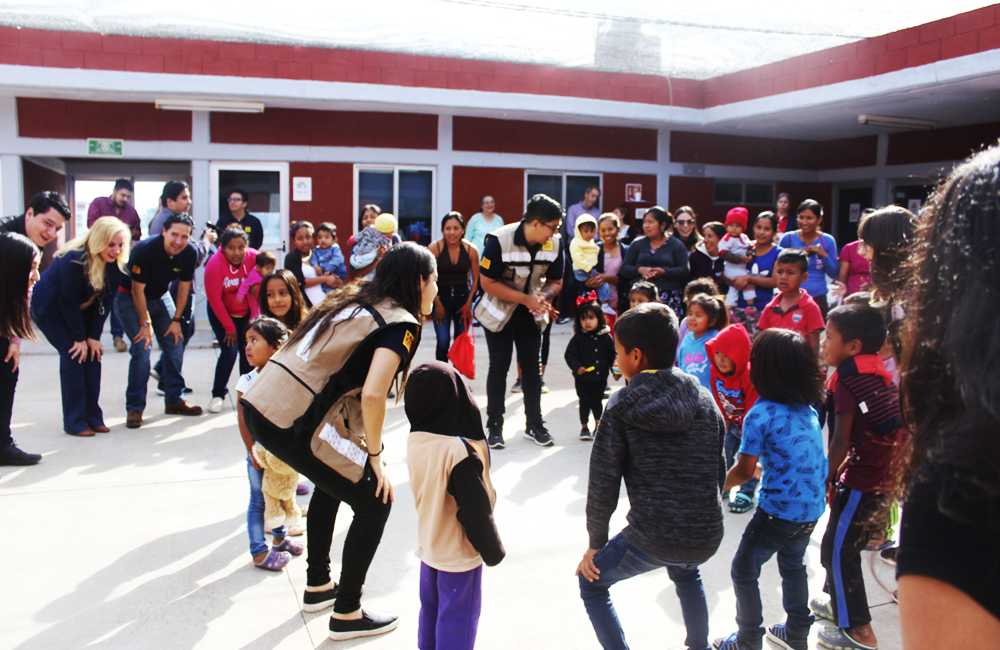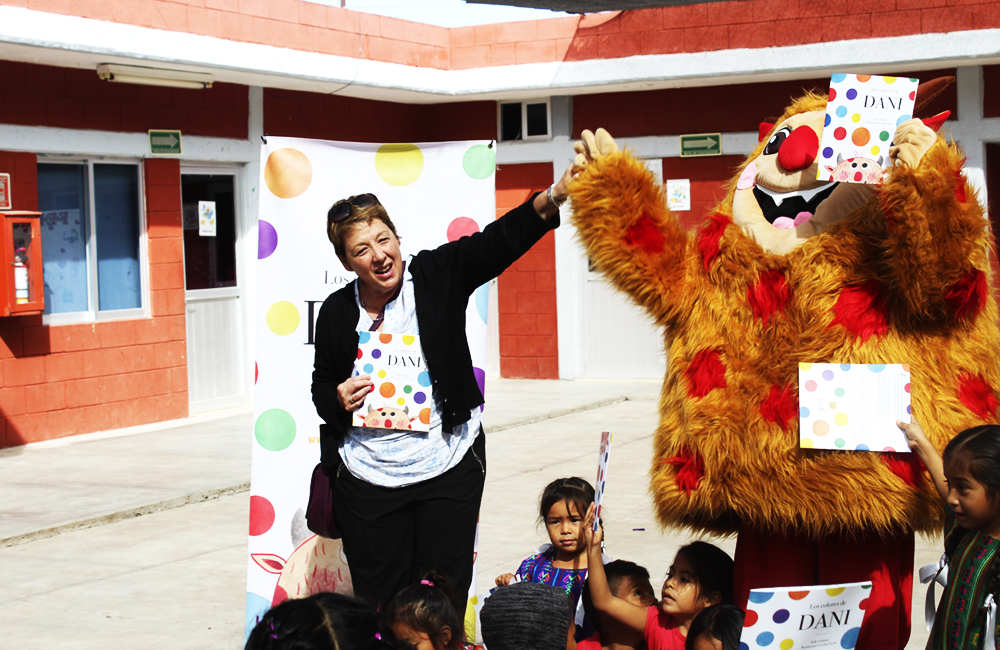Save the Children and Un Kilo de Ayuda Foundation visited the “Campo Dorita” daycare facility at Agricola Belher

On Thursday Feb 7, 2019, Save the Children Mexico and Un Kilo de Ayuda Foundation representatives visited the “Campo Dorita” daycare facility at Agrícola Belher.
The main purpose of the visit was focused on learning about stimulation activities that Un Kilo de Ayuda Foundation carries out on a daily basis with the children of farm workers who attend the daycare facility.
This event was attended by María Josefina Menéndez Carbajal, CEO of Save the Children; Jorge Vidal Arnaud, Program Manager of Save the Children in Mexico; Mariana Valdés Riveroll, Strategic Alliance Manager, and Ileana Castro Miranda, Manager of Save the Children Sinaloa.
From Un Kilo de Ayuda Foundation, this event was attended by José Ignacio Ávalos Hernández, President; Fabián Olvera, Program and Physical, Neurological, and Psychoactive Developments Manager of Un Kilo de Ayuda; Eng. Pedro Castillo, Institutional Relations Manager; and Cinthia Heraldez, Operative Coordinator of Un Kilo de Ayuda in Sinaloa; this event was also attended by Mrs. Hildelisha Ochoa de Beltrán, on behalf of her husband Eng. Antonio Beltrán Ureta; Agrícola Belher CEO, Mrs. Dora Isabel Ochoa Aguilar, HR Manager at Agrícola Belher, the work team of the daycare facilities and Eleven Rivers Growers personnel.
Mr. José Ignacio Ávalos Hernández, Un Kilo de Ayuda President said that the idea is to see if together, we can advance to another level, in order to multiply and benefit more children, as this is the purpose in practice and operation, as well as regulation, which is very important, because it obliges to require better practices from those who are not in compliance.
One of the places they visited within the daycare facility was, without a doubt, the Breastfeeding room. “The company develops a program to mothers which makes them easier to adapt to their working hours,” stated Hildelisa Ochoa de Beltrán.
The Coordinator of Un Kilo de Ayuda in Sinaloa, Cinthia Heraldez, outlined the fact that the Breastfeeding room seeks for the integration of new mothers, especially pregnant women, so that, before the birth, they already have all the knowledge on the importance of exclusive breastfeeding.
The treatment towards them and all the mothers has been customized; ladies sit, make work teams so they are aware of the importance of being a mother. It has been a hard work in conjunction with the social service personnel; but results speak for themselves, as the mothers get there alone, register on their own, and already know how proper hand wash should be carried out. They also know where extractors are located, and how to handle them; however, we should continue involving more women, conducting workshops, and keep working on this,” said Heraldez.
She also shared that the stimulation process lasts about 40 minutes, depending on the protocol being applied; if this is only for massage, if it is corrective, depending on the situation of each child.
For his part, Mr. Fabián Olvera, Program and Physical, Neurological, and Psychoactive Developments Manager of Un Kilo de Ayuda, commented how this breastfeeding room was adopted, and stated that the application of this entire services is carried out, and mothers are asked to start adopting it on their own, and then they can be sharing experiences, benefits and start asking other mothers to try it.
He also said that Sinaloa is one of the states with rates of childhood anemia due to different factors such as food or environmental, which is why it has been a challenge to work with it.
For example, in the physical subject, we have to link children’s growth by taking care of three basic indicators:
1. Optimum weight by age;
2. Optimal size by age, and;
3. Weight by size
These need to be constantly monitored. In Sinaloa, low weight in children is not a strong problem these days; however, in other Mexican states this reality is different.
In Sinaloa the problem has been anemia, as we mentioned; this is why we have the necessary equipment for monitoring; for example, digital scales that allow us to perform weight measurements bimonthly, to obtain the weight of children, and have mothers learning how to perform the interpretation of growth curves, according to age and weight of the child. Using traffic light colors, we realize that: when it is green the child is well, yellow means that there is a deviation; for example slight malnutrition; and color red means that there is a severe malnutrition which is low weight.
The same happens with the low size and weight by size, that is what this area traditionally performs in a bimonthly basis; anemia, as we mentioned earlier, is measured with a small blood drop that is placed in the reagent, the portable sound level meter is entered, hemoglobin concentration in the blood of children is quantified, and according to the cut point obtained it can be determined if there is anemia or not. If positive, supplementation for correction should be carried out, or preventive treatment. In addition, workshops related to nutritional guidance are carried out, ranging from breastfeeding and going through supplementary nutrition, and then to food for life.
Each mother has a medical record, containing growth curves, the tracking of times the hemoglobin test is conducted, treatment (in case of having received it) and in the back comes the test tracking, when was it conducted and the grade obtained, as well as the main development areas divided into: obesity, language, knowledge, etc.
We have different strategies that have been innovating in this regard, one of them is to incorporate the game into routine, the game as the best way to stimulate the brain, as the best way for learning; but to do this we must connect mothers with their own inner child, reminding them that playing is fun, it’s a natural part, this is how we learn from life and it is very important for the development of children. It must be accompanied by positive interactions and an enjoyment of both from the mother and the child to generate a better attachment, generating strong family ties.
What we do with children and adults is that we give them a small play kit with some materials containing building blocks, it has a teddy bear, crayons, stories, plasticine and they can take it home as a small intro kit, but this kit is actually a means to carry out a series of up to 8 workshops with different axes:
1. Rhythm and movement: The intention is to get kids ready for situations such as natural disaster or any other situation which could affect them emotionally; one of these activities being rhythm and movement, consisting of kids leaving memories and returning to the now, connect with themselves in present tense again in a fun manner.
2. Learning how to breathe: The benefits of proper many of us have learned in different ways is very important; it is important in sports, in measurement, and in general health.
3. Being in touch with the world: Through creation, their hands, plasticine, and the building blocks. In the case of the blocks, learning that there are blocks, walls, towers which may suddenly fall but we can lift them together. This metaphor from going to emotion and then healing in a positive manner.
4. Emotional containment or emotional expression: It has to do with talking about experiences and finding emotions; that’s what the teddy bear, the smiley faces and the stories are for. We are incorporating storytelling; we have a story in the facility named “Dani’s Colors”. This story was developed in collaboration with a highly regarded author named Judy Goldman, and it is about Dani’s day, where many things and emotions happen, and Dani is recognizing its emotions but, above all, it finds support in the family environment, in its mom and dad. Dani is a small monster which is not specified as a boy or girl. You could call it Daniela or Daniel, and the thing about Dani is that it has spots in its skin, and change color. This is emergency pedagogy; in Sinaloa we have served about 400 families and 326 children for 3 months.
Mr. José Ignacio Ávalos, Un Kilo de Ayuda President said that over 32 years ago, they realized they were not making a permanent impact so, after discussing the idea of talking about sustainability subjects, they noted that sustainability had to be experienced in person, in the individual, more so than in the environment; this is when they changed to a nutrition program but now aimed at children from 0 to 5 years old.
Weight and size were first measured, and the advantage was that not only did we have a photo now, but an accurate tracking of each child; we took measures on weight and size every 2 months; after that the anemia indicator was added to the equation, and this is where the Un Kilo de Ayuda program evolution started: from being a nutrition program, it turned into a program more focused on neurological development of the child, especially in the matter of anemia, as 30% of the oxygen we breathe affects the neurological function, which is extremely critical for children’s development.
At that time it was said that food was not the only nutrient for the development of the child, but there were other factors involved such as: food intake, oxygen, stimulation and the psycho-affective part of the environment. Then, Un Kilo de Ayuda was evolving in such manner: in the subject o anemia, we practically became the best operator in the matter, and when we began measuring the correlation between nutrition and anemia, some findings were discovered; and later when early stimulation measurements were incorporated, we realized and let the world know about this 12 years ago, that stimulationcontributes more to neurological development than food in children.
You can have a child in chronic malnutrition, but if well stimulated by the mother, no severe damages to neurological development will be carried out, and stimulation can help a lot.
This where we developed a first test in conjunction with the Faculty of Psychology at Universidad Autónoma de México; this test measured some other aspects such as fine motor skills, physical motor skills, language, sociability, adaptability, memory, etc. This is when we started on stimulation and measurement more widely, and achieved to obtain the most important database there is, correlating weight, size, blood, stimulation, fine motor skills, physical motor skills, sociability, adaptability, language, cognitive ability, all these indicators provide a very clear overview of each child.
“Save The Children has a globally tested methodology, which works in camps in Jordan, Syria, in emergency zones, what needs to be done is to be in this daily action to try to change things, that is the difference, it is the change of transformation, its fourth Transformation goes through cultural transformation of awareness, not of attitude but conscience, and that is a job being carried out by Un Kilo de Ayuda Foundation,” said María Josefina Menéndez Carbajal, Save The Children CEO.
Un kilo de Ayuda Foundation is a non-governmental organization engaged to ensuring that all children under 5 in Mexico have a complete child development, through physical, optimizing early child development through physical, intellectual and emotional development in their first years of life.
With over 30 years of work in Mexico, today we now envision the importance of investing in the Early Childhood to ensure a full Early Development of Children.
Save the Children is an organization defending children’s rights, protecting them from violence against children, malnutrition, harassment, abuse, child exploitation, and more.
To learn more from these institutions, visit their websites as follows:
Un Kilo de Ayuda Foundation: https://www.unkilodeayuda.org.mx
Save the Children: https://www.savethechildren.mx/
Agrícola Belher: https://www.agbelher.com/es





































